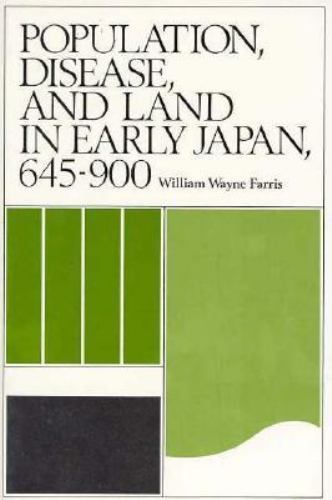Picture 1 of 1

Stock photo

Picture 1 of 1

Stock photo

Harvard-Yenching Institute Monograph Ser.: Population, Disease, and Land in Early Japan, 645-900 by William Wayne Farris (1995, Trade Paperback)

Rarewaves (685582)
98.8% positive feedback
Price:
$31.92
Free shipping
Returns:
30 days returns. Buyer pays for return shipping. If you use an eBay shipping label, it will be deducted from your refund amount.
Condition:
Title: Population, Disease, and Land in Early Japan, 645–900. The function and nature ofritsuryō institutions are reinterpreted within the revised demographic and economic setting. Author: William Wayne Farris.
Oops! Looks like we're having trouble connecting to our server.
Refresh your browser window to try again.
About this product
Product Identifiers
PublisherHarvard University, Asia Center
ISBN-100674690052
ISBN-139780674690059
eBay Product ID (ePID)1054283
Product Key Features
Number of Pages252 Pages
Publication NamePopulation, Disease, and Land in Early Japan, 645-900
LanguageEnglish
SubjectDemography, Asia / Japan, Development / Economic Development
Publication Year1995
TypeTextbook
AuthorWilliam Wayne Farris
Subject AreaSocial Science, Business & Economics, History
SeriesHarvard-Yenching Institute Monograph Ser.
FormatTrade Paperback
Dimensions
Item Height0.8 in
Item Weight14.3 Oz
Item Length8.9 in
Item Width6 in
Additional Product Features
Intended AudienceScholarly & Professional
LCCN84-022576
ReviewsThese discussions of people and land in Japan's classic age are major contributions to Western Japanology and should attract wide interest among scholars concerned with premodern populations. Never before has this material been presented so effectively in a Western language., The time span of the book is the two and a half centuries when Japan came under the influence of Chinese civilization; peasant life evolved from subsistence patterns to settled farming, primitive forms of political organization developed, there was a dramatic population increase, and the Japanese rulers adopted the Chinese model of census-taking. [Farris] has applied modern demographic techniques to these abundant, if fragmentary, tax and household data, giving a fascinating account of preindustrial society., This [book] is based on an impressively wide and careful study of the official histories, extant administrative and fiscal documents, and extensive modern Japanese scholarship in such fields as economic history and archaeology.
Series Volume Number24
IllustratedYes
SynopsisW. Wayne Farris has developed the first systematic analysis of early Japanese population, the role of disease in economic development, and the impact of agricultural technology and practices. In doing so, he reinterprets the nature of ritsuryo institutions., From tax and household registers, law codes, and other primary sources, as well as recent Japanese sources, William Wayne Farris has developed the first systematic, scientific analysis of early Japanese population, including the role of disease in economic development. This work provides a comprehensive study of land clearance, agricultural technology, and rural settlement. The function and nature of ritsuryo institutions are reinterpreted within the revised demographic and economic setting. Farris's text is illustrated with maps, population pyramids for five localities, and photographs and translations of portions of tax and household registers, which throw further light on the demography and economy of Japan in the seventh, eighth, and ninth centuries.
All listings for this product
Be the first to write a review





















